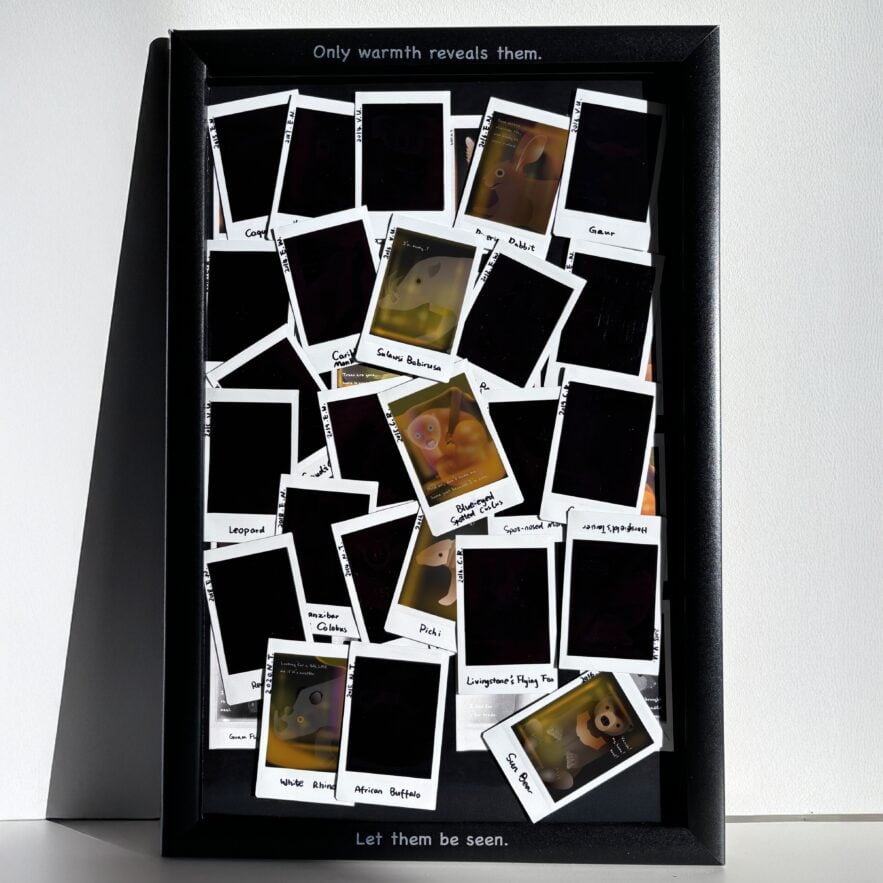By Lauren Keaton
In an age of ecological uncertainty, three designers—Yefan Liu, Zilan Zhou, and Jiayi Chen—have created a project that invites us not just to see, but to feel extinction. Their collaborative interactive installation, Thermal Animals, turns something as intimate as body warmth into a quiet act of empathy and awareness.
On the surface, the installation appears minimal: dozens of black and blank Polaroid photos rest quietly on the wall. But the moment a visitor touches one with their hand, a figure begins to emerge— an endangered animal, revealed by the warmth of a human hand. As the photo cools, it vanishes again, echoing the fragile presence of lives fading from our world.
“In a way, your touch is bringing the animal to life,” the artists explain. “ You bring the animal into being, only to watch it disappear: we are both witnesses to and participants in their vanishing.”
Material Innovation Meets Emotional Narrative
Behind this subtle poetry lies meticulous material testing, custom printing techniques, and over 70 hand-illustrated animal portraits sourced from the IUCN Red List. The photos are printed on specially treated thermal-reactive materials that react to even the softest touch—turning each interaction into a micro-performance of environmental memory.
The team spent months iterating on surface textures, heat thresholds, and environmental sensitivity to ensure the work could function in a range of public settings. Their approach combines graphic storytelling, thermal science, and ecological education, creating an installation that is both intellectually rigorous and emotionally disarming.
From Installation to Education, Advocacy, and Design
But Thermal Animals is just the beginning. The project has become a starting point for something larger—a growing effort to turn art into action. Upcoming plans include:
- Museum and School Kits: Educational versions of the installation that allow children and students to uncover species, read their stories, and reflect on their future. These kits will include thermal cards, conservation booklets, and lesson plans.
- Public Murals and Pop-Up Installations: Large-scale versions of Thermal Animals that respond to sunlight or human touch, designed for parks, libraries, and urban spaces.
- Sustainable Giftware and Home Objects: The team is prototyping heat-reactive postcards, wall art, and collectibles to bring environmental awareness into everyday routines.
- NGO Collaborations and Wildlife Funding: A portion of future proceeds will support conservation groups through co-branded merchandise and fundraising campaigns.
- Digital Twin / AR Integration: Future versions of the project may include an AR layer, where scanning a photo reveals additional information or 3D animations of animal movement and habitats.
“We want people to feel like they’re part of something living—not just remembering loss, but actively preserving what remains.”
Designing for Empathy, Not Just Objects
More than an installation, Thermal Animals acts as a design framework for empathy. The act of revealing the animal becomes a metaphor: if you touch it, it exists—if you don’t, it fades away. This act of presence contrasts sharply with the distance of our increasingly digital lives, turning physical connection into a reminder of care and responsibility.
The three designers bring complementary strengths to the project:
- Liu focuses on ecological storytelling and user experience design.
- Zhou brings a background in material research and interactive installation.
- Chen specializes in system planning, education integration, and public engagement.
Together, they embody a shared belief that design can do more than communicate—it can move, connect, and mobilize.
Toward a Shared Vision of the Future
Ultimately, Thermal Animals is not about nostalgia. It’s about possibility. In a world where environmental headlines often feel overwhelming, this project brings attention back to something intimate and human.
It poses a simple question: If your touch could bring an endangered life into view, would you reach out?
If your warmth meant its existence, would you still look away? Perhaps that single moment of appearance is where change begins.


